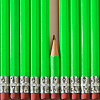Skip over navigation


Or search by topic
Number and algebra
Geometry and measure
Probability and statistics
Working mathematically
Advanced mathematics
For younger learners
Hex
Age 11 to 14
Challenge Level 






Explain how the thirteen pieces making up the regular hexagon shown in the diagram can be re-assembled to form three smaller regular hexagons congruent to each other.
Click here for a poster of this problem.
You may also like
How Big?
If the sides of the triangle in the diagram are 3, 4 and 5, what is the area of the shaded square?
Triangular Tantaliser
Draw all the possible distinct triangles on a 4 x 4 dotty grid. Convince me that you have all possible triangles.


